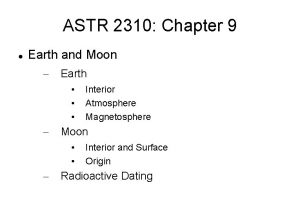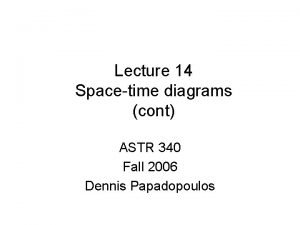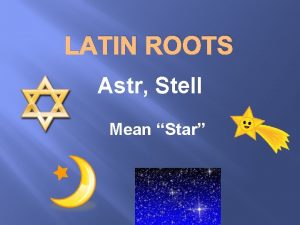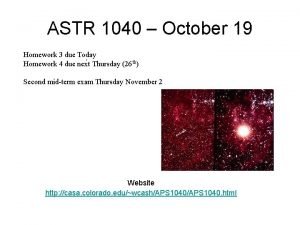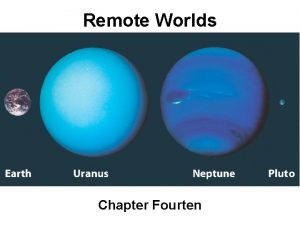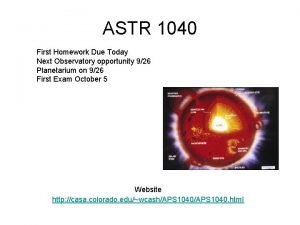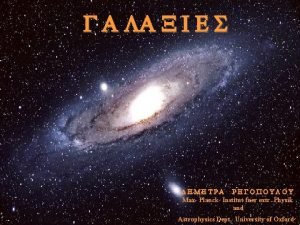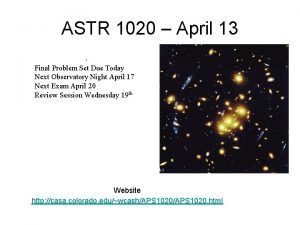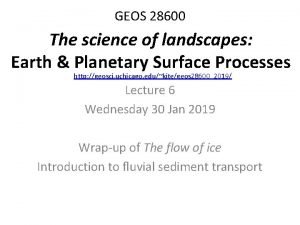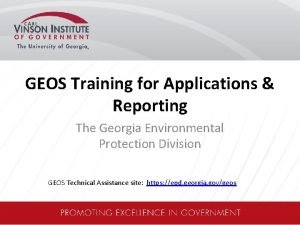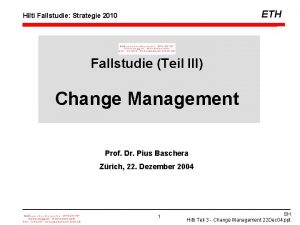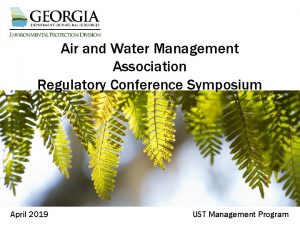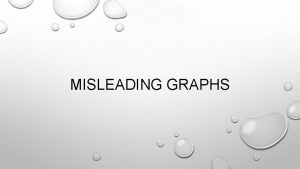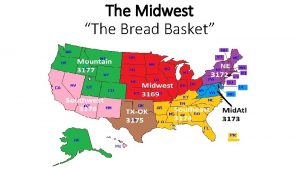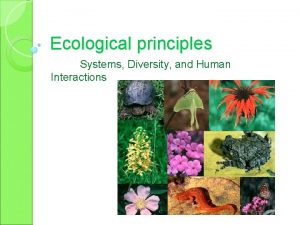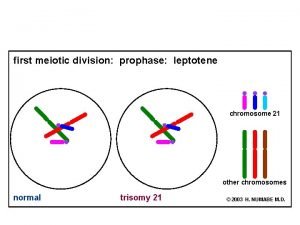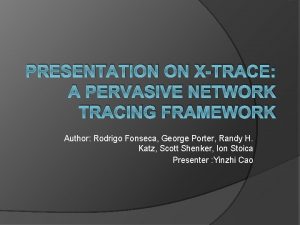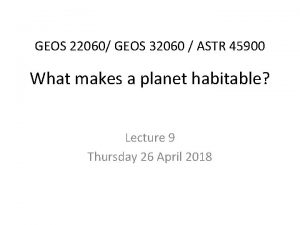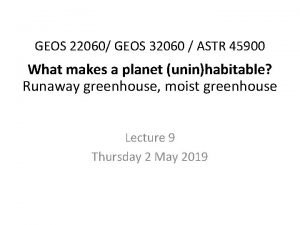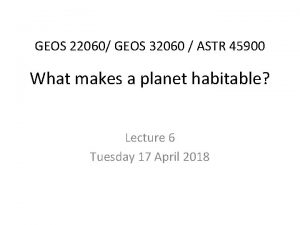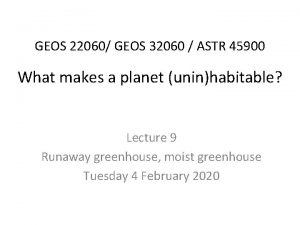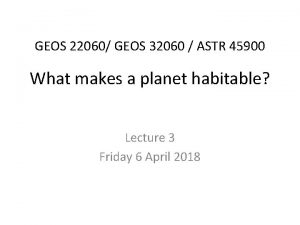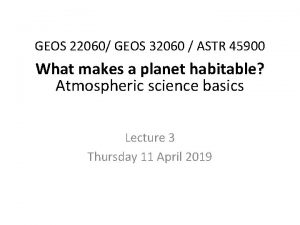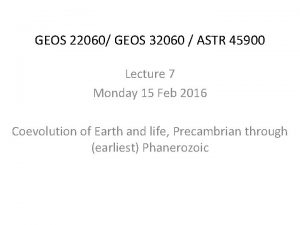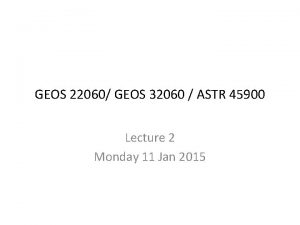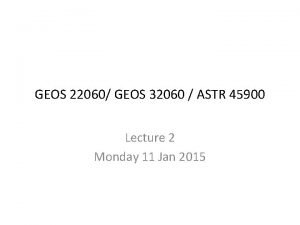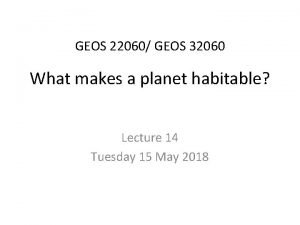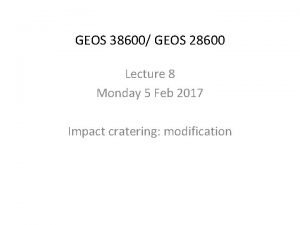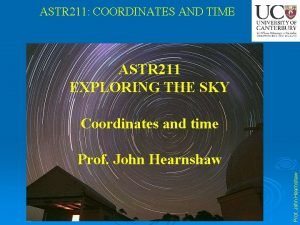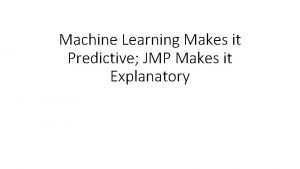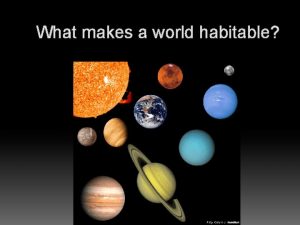GEOS 22060 GEOS 32060 ASTR 45900 What makes
































- Slides: 32

GEOS 22060/ GEOS 32060 / ASTR 45900 What makes a planet habitable? Lecture 8 Tuesday 24 April 2018

Today • Homework 2 is due now • Graduate students + undergraduates who choose the term paper option: Send term paper topics to kite@uchicago. edu before end Fri 27 for approval. Term papers due in at the start of the final (10: 30 a-12: 30 p , Thu 7 June , HGS 180) • Designation of presenters for Appendix A of Lehmer et al. 2017 and Sections 3 & 4 of Schlichting & Mukhopadhyay 2018 • Homework 3 to be posted 9 a tomorrow, due in class Tue 1 May • Office hours after class Thursday • Presentation of Walker et al. 1981 by Johanna Holo and Andy Heard • Volatile escape: the diffusion limit & impact-driven atmospheric erosion

Recap of key points from Watson et al. 1981 dimensionless temperature all XUV assumed to be absorbed at a single level sonic point skin temperature (loosely: stratospheric temperature) Pd. V work done on ascending fluid cools the flow distance down gravity well

Key assumptions in Watson et al. 1981 • Collisional at sonic level (bad approxm. for Titan and Pluto) • No convective adjustment • Single-component • H/H 2 dominated • Neutral (vs. ionized) outflow

Course outline Foundations (1 -2 weeks) • • • Earth history HZ concept, atmospheric science essentials Post-Hadean Earth system Principles – how are habitable planets initiated and sustained? (4 -5 weeks) • • • Volatile supply, volatile escape TODAY Runaway greenhouse, moist greenhouse – Thu 26 April & Tue 1 May Long-term climate evolution – Thu 3 May & Tue 8 May Specifics (2. 5 weeks) • • Earth science Hyperthermals on Earth – Thu 10 May & Tue 15 May Early Mars – Thu 17 May Oceans within ice-covered moons – Thu 24 May Exoplanetary systems e. g. TRAPPIST-1 system – Tue 29 May planetary science

Atmospheric escape – key unifying concepts • Energy sources for atmospheric escape – Thermal, individual-photons, solar wind, impacts • Bottlenecks for atmospheric escape – Energy supply, exobase, homopause, condensation in atmosphere, condensation at surface • Escape parameter, exobase, Jeans escape • The role of the sonic point in hydrodynamic escape

Energy sources for atmospheric escape Today not covered in this course today also: lag formation via James Wray

Bottlenecks for atmospheric escape Today carriers of H in Earth’s atmosphere for minor constituent:

Lecture 8 topics • Energy-limit: XUV driven escape more-likelythan-not sculpts the exoplanet radius-period distribution (‘photo-evaporation valley’) • Diffusion limit: what regulates H loss from Venus, Earth and Mars today • Impact erosion – giant impacts and planetesimal impacts

Lecture 8 topics • Energy-limit: XUV driven escape more-likelythan-not sculpts the exoplanet radius-period distribution (‘photo-evaporation valley’) • Diffusion limit: what regulates H loss from Venus, Earth and Mars today • Impact erosion – giant impacts and planetesimal impacts

XUV-limited atmospheric escape predictions for Kepler exoplanets Lopez et al. Ap. J 2012

Fulton et al. Astronomical Journal 2017 Improved stellar radii reveal, via transit depth = (Rp/Rs)^2, a gap in the radius distribution of planets

The Galaxy has many H 2 -absent Super-Earths and many >~1 wt% H 2 mini-Neptunes: not much in between mostly not rocky based on density data (L. Rogers Ap. J 2015) harder to detect < 1. 6 R_Earth planets >1. 6 R_Earth planets van Eylen et al. ar. Xiv 2017

This gap in the radius distribution can be understood as a photo-evaporation valley driven by hydrodynamic escape of hydrogen Owen & Wu Ap. J 2017

This gap in the radius distribution can be understood as a photoevaporation valley driven by hydrodynamic escape of hydrogen Owen & Wu Ap. J 2017

Tian & Ida Nature Geoscience 2015 UV-driven atmospheric escape is predicted to lead to a bimodal distribution of water abundance in the habitable zone

Lecture 8 topics • Energy-limit: XUV driven escape more-likelythan-not sculpts the exoplanet radius-period distribution (‘photo-evaporation valley’) • Diffusion limit: what regulates H loss from Venus, Earth and Mars today • Impact erosion – giant impacts and planetesimal impacts

Diffusion-limited escape is an upper-bound on atmospheric escape

Heavy gases settle out due to buoyancy

Homopause as bottleneck for atmospheric escape Catling & Kasting section 5. 8: for a light gas diffusing through a heavy gas, with small temperature gradients

Lecture 8 topics • Energy-limit: XUV driven escape more-likelythan-not sculpts the exoplanet radius-period distribution (‘photo-evaporation valley’) • Diffusion limit: what regulates H loss from Venus, Earth and Mars today • Impact erosion – giant impacts and planetesimal impacts

History and methods of impact research Nuclear tests Hydrocode Terrestrial impact craters Two-stage gas gun

Different treatments of atmospheric escape: Cookie -cutter, point explosion, tangent plane

Formation of Earth-sized planets involves giant (oligarchic) impacts. Masses of resulting planets (Earths) * = giant impacts The output underlying this plot was generated by C. Cossou. Simulation intended to reproduce “typical” Kepler system of short-period, tightly-packed inner planets The Moon-forming impact was not the last big impact on Earth, but it was the last time that Earth hit another planet.

The atmosphere-loss escape efficiency of giant impacts is set by the ground-motion speed Schlichting & Mukhopadhay 2018

Impacts by small asteroids/comets efficiently eject ~1 bar atmospheres The peak would move to larger r if the initial atmospheric pressure were greater

Ocean removal by giant impacts? (Ocean vaporization is not sufficient for ocean removal) Simulations suggest that the Moonforming impact was marginally able to remove any pre-existing Earth ocean Qs ~ ve 2 for oligarchic impact Stewart et al. LPSC 2014 escape velocity There have also been major recent developments in our understanding of Moon formation, the Moon’s orbital evolution, and Moon-induced tidal heating, but orbital/tidal effects are not part of this course.

Total impactor mass needed to eject the atmosphere as a function of impactor radius Schlichting & Mukhopadhay 2018

EARTH-SPECIFIC Schlichting & Mukhopadhay 2018

Catling & Kasting ch. 6 (Fig. 6. 18)


Backup/additional slides
 Chapter
Chapter Twin paradox
Twin paradox Astr greek or latin
Astr greek or latin Astr
Astr Astr 100 uiuc
Astr 100 uiuc Astr
Astr Homework due today
Homework due today Cronou
Cronou 5-a-day language review week 11
5-a-day language review week 11 Astr
Astr Epd geos
Epd geos Geos plumbing services
Geos plumbing services Geos georgia
Geos georgia Geos hilti
Geos hilti Restaurant pro forma
Restaurant pro forma Geos epd
Geos epd Canadian collective rights
Canadian collective rights Misleading graphs in advertising
Misleading graphs in advertising Bread basket of america
Bread basket of america What is a limerick
What is a limerick Ecology diversity
Ecology diversity What makes a good questionnaire
What makes a good questionnaire Meiotic division
Meiotic division Ella makes the generalization that a 4s fact
Ella makes the generalization that a 4s fact Angiosperm with one seed leaf
Angiosperm with one seed leaf Market forms of poultry with definition
Market forms of poultry with definition Why is macbeth fearful of banquo
Why is macbeth fearful of banquo Materials that are useful but can also be harmful
Materials that are useful but can also be harmful Nursing supervisors are selected using random numbers
Nursing supervisors are selected using random numbers X-trace: a pervasive network tracing framework
X-trace: a pervasive network tracing framework What branch of the government makes treaties
What branch of the government makes treaties How do you know something is alive?
How do you know something is alive? The five cs of pricing
The five cs of pricing
